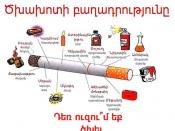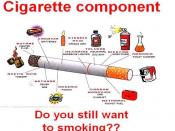Cigarettes and Their Destruction of the Brain
Smokers generally feel more comfortable after that especially important first cigarette of the day. Within just a few seconds of 'lighting up,' smoking activates mind-altering changes. Smokers are well aware of the long-term risks of their habit: such as lung cancer, heart disease, emphysema, and other deadly illnesses. However, smokers are attracted by the immediate effects of smoking: 'a stimulant that makes them seem to feel more alert, clearheaded and able to focus on work.' Smoking however, does not really have these effects; what the smoker perceives is an illusion. Nicotine begins to act on brain cells within ten seconds of inhalation, fitting into 'keyholes' on the surface of the brain; the same 'keyholes' as acetylcholine(an important neurotransmitter), and mimicking epinephrine and norepinephrine, giving the smoker a rush, or stimulation. Within 30 minutes, smokers feel their energy begin to decline, as the ingested nicotine is reduced.
This process continues, as the smoker's attention becomes increasingly focused on cigarettes. Nicotine causes smokers' brain cells to grow more nicotinic receptors than normal; therefore, the brain may function normally despite the irregular amount of acetylcholine-like chemical acting upon it. The brain is reshaped: the smoker feels normal with nicotine in his system, and abnormal without it. A series of tests were conducted on nonsmokers, 'active' smokers, and 'deprived' smokers. The 'active' smokers were given a cigarette before each test, while the 'deprived' smokers were not allowed cigarettes before tests.
The tests started simply, and then moved towards more complex problems. In the first test, subjects sat in front of a computer screen and pressed the space bar when a target letter, among 96, was recognized: smokers, deprived smokers, and nonsmokers, performed equally well. The next test involved scanning sequences of 20 identical letters and as one...



Suggestion
Perhaps presenting it in a more experiment process, and analyzing results more would have been good
0 out of 0 people found this comment useful.